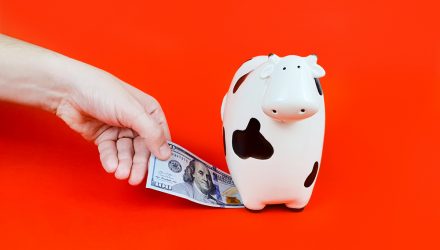ETF Trends CEO Tom Lydon discussed the Pacer US Cash Cows 100 ETF (COWZ) on this week’s “ETF of the Week” podcast with Chuck Jaffe on the MoneyLife Show.
COWZ is a strategy-driven ETF aiming to provide capital appreciation over time by screening the Russell 1000 for the top 100 companies based on free cash flow yield.
The free cash generation is likely to provide a truer valuation comparison between companies. Free cash flow is the cash left over after a company has paid expenses, interest, taxes, and long-term investments. It is used to buy back stocks, pay dividends, or participate in mergers and acquisitions.
The ability to generate a high free cash flow yield indicates that a company is producing more cash than it needs to run the business, which can then be invested in growth opportunities. Free cash flow producing companies generally have three defining characteristics – they are productive, reliable, and self-sufficient.
The companies generate more cash flow than they spend, which allows them to grow without external financing. Free cash flow is a sturdy measure of profitability than earnings, which are subject to manipulation and accounting assumptions. Lastly, as the companies are less reliant on capital markets for financing, they won’t dilute their issued company stocks.
Using free cash flow yield to measure a company’s sustainability may produce potentially higher returns and more attractive upside/downside capture over time.
Value Investing
From 1926 to 2020, there were 16 periods of sustained value outperformance, on average lasting 39 months. Over the last ten years, value has rallied only twice. The last ten years have seen the worst returns ever for US value stocks versus growth. This was even worse than during the dot-com bubble.
Rethinking value investing – there were problems with traditional measures of value. The price-to-book ratio remains a key input to all major value indexes. From 1960 to 1989, the cheapest 20% of stocks based on P/B significantly outperformed the most expensive 20%. However, from 1990 through 2020, the relative performance of the cheapest P/B stocks was much more muted.
P/B then ceased to be as effective as the economy shifted toward intangible investments that are not captured. Traditional book value makes less sense in an economy driven by intangibles, such as patents, licensing agreements, proprietary data, brand value, and network effects. What is more valuable to a company like Google? The physical buildings and the network servers inside of them, or the intangible algorithms running on those servers?
Now, companies’ value and ability to generate free cash flow mostly is a result of their intangible assets. Traditional book value(assets minus liabilities) ignores many of the most important resources to companies today. Market leaders such as enterprise software firms generate cash flows in ways not easily recognized by conventional valuation metrics.
More free cash flow is tied to the intangible asset. Because free cash flow is less distorted by accrual-based accounting rules, measures of free cash generation are likely to provide a truer valuation comparison between firms. Looking at free cash flow in relation to enterprise value puts companies on more equal footing and presents a more comparable picture of valuation. Looking at COWZ, free cash flow yield = free cash flow/enterprise value (or market cap + debt – cash).
Listen to the full podcast episode on the COWZ:
For more podcast episodes featuring Tom Lydon, visit our podcasts category.

